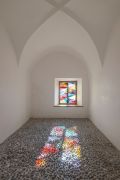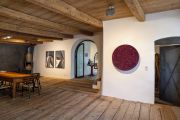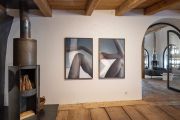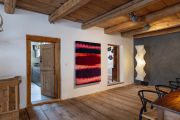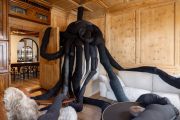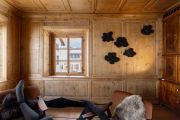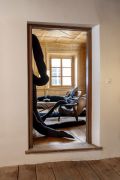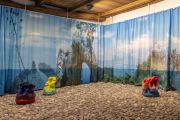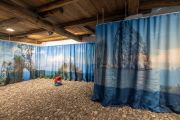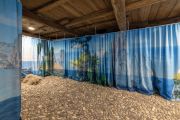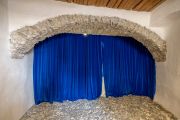Wiedemann/Mettler
unexpected desire
August 3 – September 15, 2024
Galerie Urs Meile Ardez
Opening:
Saturday, August 3, 2024; 4 – 7pm
press release english
By Philipp Sarasin
Behind heavy, opaque curtains, spaces of longing and reverence, spaces of terror or spaces of desire and lust unfold – in the theater or in the brothel, before the crime scene or the place reserved for the medical gaze, before the altar or the sanctuary... Throughout art history since Giotto, curtains have opened to reveal glimpses of heavenly hosts; often temptingly semi-transparent, curtains up to modern art continually pose the question of the relationship between inside and outside, inclusion and exclusion, concealment and revelation. In any case, the curtain is never an insurmountable barrier, but both boundary and mediator, a movable line between two worlds. Whoever steps through it is transformed. Behind the curtain, a heterotopic space opens up, separated from the outside and the before, yet simultaneously preserving and revealing its mystery.
The space into which Wiedemann/Mettler lure the viewers reveals the image of a landscape of longing. Anyone standing here knows, of course, that the Engadine is also such a landscape elevated far above the lowlands, bathed in light, a landscape that has long attracted weary city dwellers, artists, and overstimulated philosophers. But here, in the space enclosed by the curtain, one does not see mountains, but the sea in the southern light of the distant island of Capri, framed by bleached rocks and some plants enduring the midday heat. It is no coincidence that the landscape, in the promisingly glowing blue of the sky that merges with the sea at the horizon, recalls the ideal landscapes bathed in blue, iridescent light that frame the biblical scenes in the foreground in the vanishing points and horizons of many paintings of the Italian Renaissance. Capri’s landscape already appeared ideal, indeed almost utopian, to Herder and Goethe, who “discovered” it at the beginning of the 19th century.
Thus, like the Engadine, Capri repeatedly attracted philosophers, artists, and those disgusted by the big city in the 19th century and well into the 20th century (followed by the beautiful and rich of our days); the island appeared to them as a place of supposed originality and fullness of life beyond all the shadows of modern life. For some, this idealized image of the authentic and light-filled purity of Capri condensed particularly in the figure of the sun-tanned boy or young man who smiled at the strangers next to the fishing boats in the harbor. It was not only unexpected but quite predictable desires of Northern European civilization escapees that were directed towards him. Longing and desire are ambivalent emotions and forces, by no means always as ideal as the landscape through which they wander.
Wiedemann/Mettler make this tension visible, indeed intensely recognizable, in the figure of the “Monk,” who squats more than stands on a rock belonging to the real space. In fact, it is Friedrich’s “Monk by the Sea” that Wiedemann/Mettler reference, turning this iconic painting inside out. Friedrich’s monk stands as a small human nothing before the overwhelming, darkly threatening nature of the sea and the cloud-covered horizon. He seems to have every reason to be afraid, or at least to feel deep reverence for God and nature. Wiedemann/ Mettler’s “Monk,” on the other hand, is not frightened by Capri’s bright landscape – yet, strangely enough, he has lost his human form, appearing merely as an amorphous entity. For this “Monk” is not a fearful human being, but the outwardly turned “inner” of someone who – for example – comes to Capri: the raw, formless desire flooding and driving the body, that something that squats on the rock of the real and, as an amorphous, crude, even ugly “inner” form, confronts all biblical scenes and monks of European art history with what they hide. Behind Wiedemann/Mettler’s curtain, not only does the ideal space of a southern landscape of longing open up, but also the abyss of desire.
In the second room, the small white one with the beautiful vaulted ceiling, all this seems forgotten and forgiven: Through a stained glass window, calm, colored light streams in, reminiscent of the fact that such windows have depicted colorful images of biblical scenes in churches and cathedrals since the High Middle Ages, intending to visually teach the illiterate people – or, in the form of giant rosettes, to symbolize divine harmony and perfection. This world has long since sunk. Nevertheless, Ólafur Elíasson recently created three image-less glass windows for the Greifswald Cathedral – the birthplace and long-term workplace of Caspar David Friedrich – which, through their deliberately conventional color scheme, seem to connect to this religious tradition. Wiedemann/Mettler’s position differs radically from this. Though their window’s mouth-blown glass also recalls the great era of religious glass art, its parts, like fragments, no longer piece together into a “meaning” – indeed, they consistently renounce any claim to generate a “spiritual” mood. Wiedemann/Mettler’s window rather poses the question: What remains when only fragments are left to us? – and gives the answer: Art! Meaning, the beautiful, perhaps the sublime, replaces those lost religious certainties without ever being able to return to an unbroken, unsplintered image of long-past truths.
In the third room staged by Wiedemann/Mettler, however, despite this gesture of holding on to the beauty of art, horror, even terror, re-enters the field of perception. Five lava-like protrusions cling to the wall, formless, black, sharply gleaming as if just solidified, and through the opening commonly found in Engadine houses above the tiled stove, which allows warmth to be transferred to an upper chamber, the tentacle-like long arms of an unidentified creature threateningly reach into the room. Is this the ironic comment of the two artists, who grew up in the alpine region themselves, on the longings of city dwellers to find purity, peace, and tranquility here in the mountains – or in Capri? A mocking hint at the nameless horrors that can suddenly erupt in the warm rooms and stately houses of these places of longing despite all appearances? Or, as Slavoj Žižek would say, aren’t the black, sharply edged protrusions on the wall and the tentacles from the upper chamber the real essence of that desire already represented by the “Monk,” the real essence of those excesses that appear to the weary and overstimulated here or in Capri as their “liberation” from the burdens of civilization...?
Philipp Sarasin, Prof. emeritus at the University of Zurich, is a historian and photographer. He recently published “1977. A Short History of the Present” (Suhrkamp 2021/2024).
downloads
Press Release (PDF English)
Press Release (PDF German)
Opening Hours
Friday to Sunday, 3 – 6 pm
and by appointment

